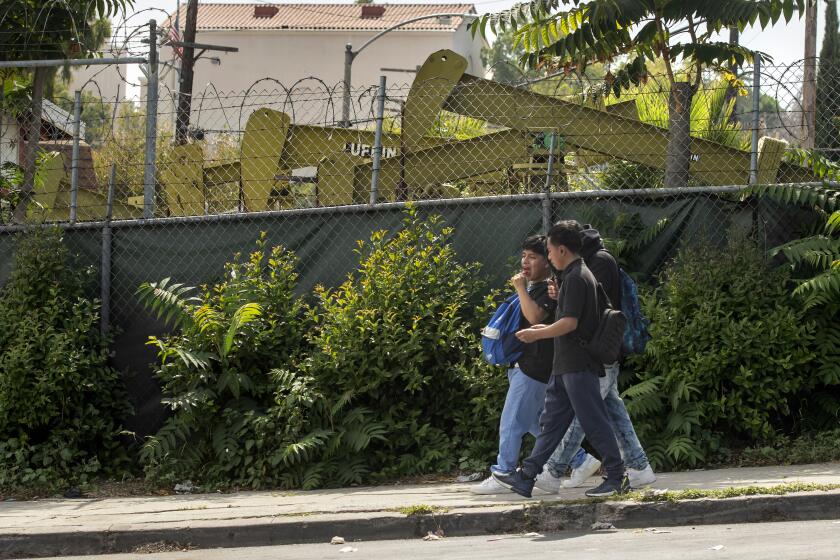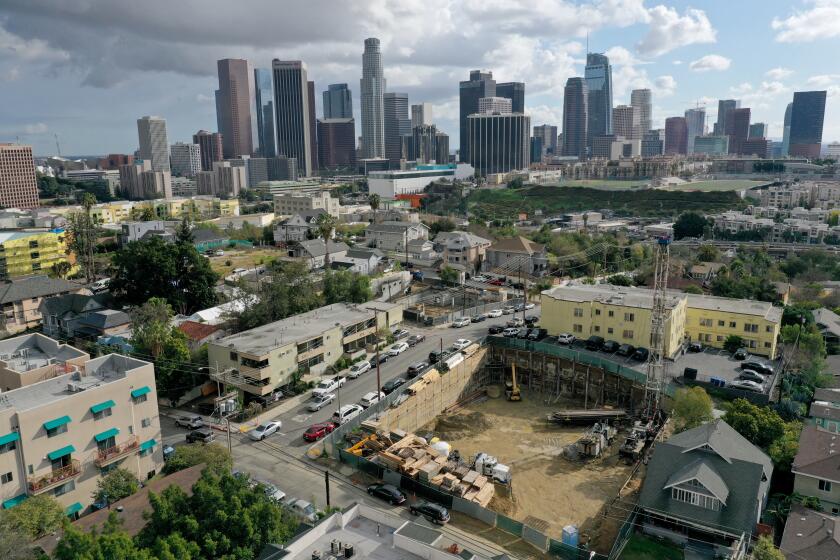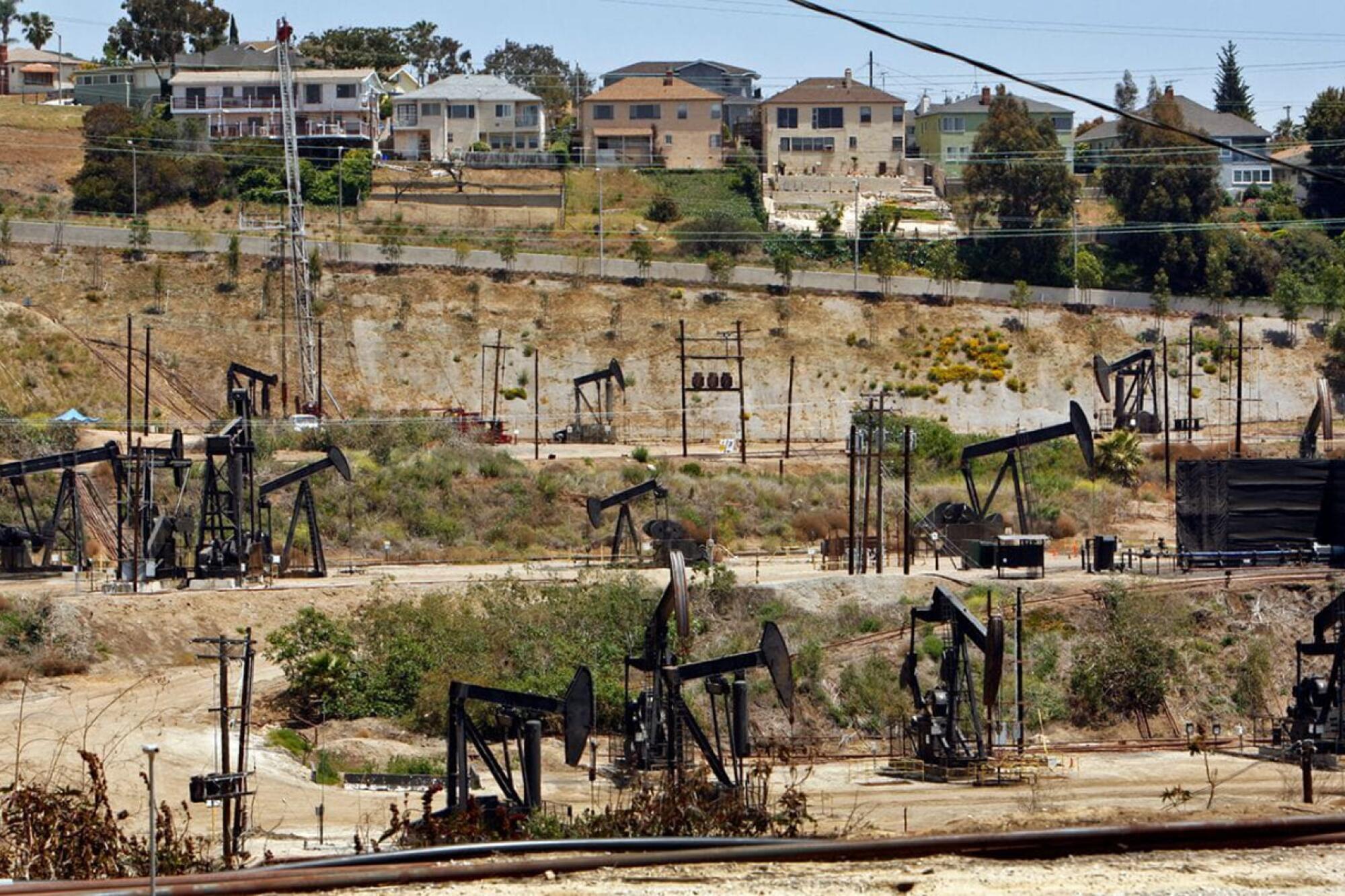
- Share via
As firefighters continue to battle more than two dozen active wildfires in California, new research has found that millions of people are living close to oil and gas wells that are in the potential path of flames.
More than 100,000 wells in 19 states west of the Mississippi River are in areas that have burned in recent decades and face a high risk of burning in the future, with the vast majority in California, according to a study published recently in the journal One Earth.
What’s more, nearly 3 million Americans live within 3,200 feet of those wells, putting them at heightened risk of explosions, air and water pollution, infrastructure damage and other hazards.
“One of the things that surprised me was just the extent of how many oil wells had been in wildfire burn areas in the past, and how much this was impacting people in California — and is likely to in the coming century,” said David J.X. González, the study’s lead author and an assistant professor of environmental health sciences at UC Berkeley.
Aggressive and impactful reporting on climate change, the environment, health and science.
California is particularly vulnerable to the threat. Of the roughly 118,000 western oil wells in high fire risk areas, 103,878 of them — more than 87% — are in California, with 2.6 million residents living in close proximity to them, according to the study, which was described as the first to investigate historic and projected wildfire threats to oil and gas infrastructure in the United States.
The researchers examined active and inactive oil wells because some inactive wells continue to leak methane and other harmful or combustible emissions, González said. In California, the danger is particularly high in Los Angeles, Fresno, Kern and Orange counties, which are high fire risk areas that are also home to large populations and numerous wells.
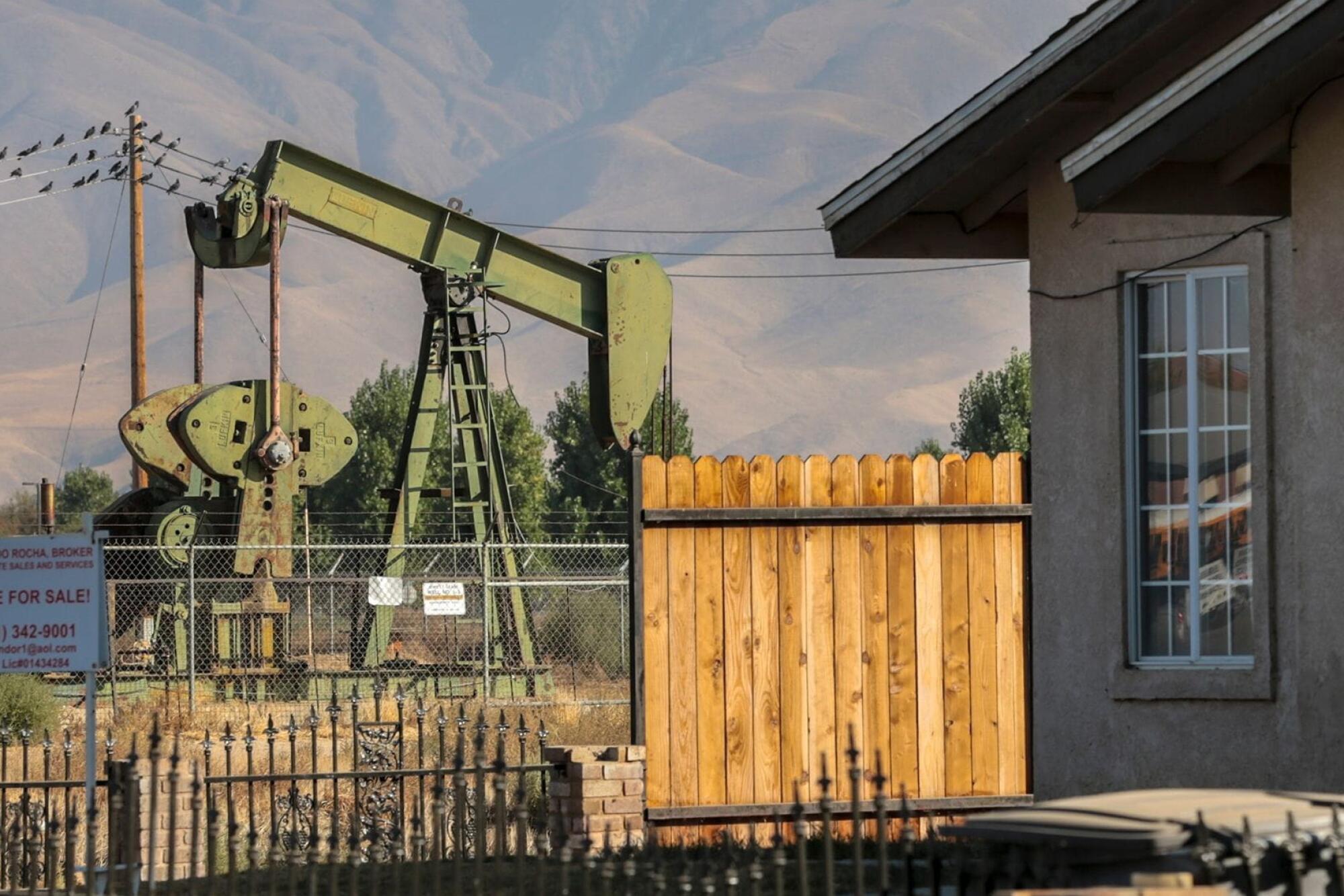
Many Angelenos have already experienced the perils of living near oil and gas infrastructure. In 1985, methane linked to a long-abandoned oil field fed an explosion at a Ross Dress for Less store in Fairfax, injuring more than 20 people.
In 2015, a massive gas leak from the Aliso Canyon underground storage facility near Porter Ranch released about 100,000 tons of methane, ethane and other chemicals into the air, forcing more than 8,000 families to flee their homes and prompting reports of nausea, skin rashes, nosebleeds and other health issues.
Four years later, a 90-year-old well erupted beneath a construction site in Marina del Rey and spewed oil, gas and other debris into the air for several days.
And in 2017, the Thomas fire burned through areas of Santa Barbara and Ventura counties that contained more than 2,100 oil and gas wells — the long-term effects of which have yet to be studied.
It’s not only California that is at risk however. Texas, Oklahoma and New Mexico also host wells in high fire risk areas, the study says. The U.S., in general, has been the top global producer of crude oil and natural gas since 2014, with the majority of production concentrated in the West.
Additionally, oil drilling continues across the country, despite federal and state efforts to curb new wells and cap old ones. One of the provisions included in President Biden’s landmark climate bill, the Inflation Reduction Act, allows for new oil leases to be auctioned on federally managed lands, which means California and other states could see more new wells in the future.
But the California Department of Geologic Energy Management, which oversees oil and gas wells in the state, said production here has been steadily declining since its peak in 1985.
“Presently, CalGEM approves far more permitting applications from operators to plug oil wells than it does to drill new wells,” agency spokeswoman Janice Mackey said in an email. She noted that over the last 12 months, the state agency approved 5,059 permits to permanently plug oil and gas wells while approving only 56 new drills.
Mackey said most of the nearly 250,000 wells under the state agency’s jurisdiction are in the San Joaquin Valley, “but there are also many others in high fire threat areas such as Santa Barbara, Ventura, and Los Angeles counties.”
That could prove to be a problem as wildfire activity continues to worsen, even in the face of slowing oil production. One recent study found that wildfire burn areas in California could increase 50% or more by midcentury, due largely to climate change. Eighteen of the state’s 20 largest wildfires have occurred since 2000.
Additionally, Mackey said the placement of new wells — which are determined by oil and gas operators who seek permits from local governments — has little to do with fire risk.
“California’s oil fields are well established from decades to [over a] century old,” she said. “Operators continue to drill in areas where oil and gas is known to exist.”
The Biden administration funding is among the “largest ever in American history to address legacy pollution,” U.S. Secretary of the Interior Deb Haaland said.
Estimates included in the study indicate the hazards will get worse in the decades ahead as population and wildfire activity expand. Between 1984 and 2019, the researchers documented a five-fold increase in the number of wells located in wildfire burn areas, and a doubling of the population living within 3,200 feet of those wells.
By midcentury, more than 122,000 wells are expected to be in high wildfire risk areas, and by late century that number will grow to more than 205,000, according to the study. Both projections are significantly higher when also accounting for moderate wildfire risk areas, and both show that California will continue to experience the lion’s share.
“Wildfires are increasingly burning in oil fields over the past four decades, and it’s a trend that’s very likely to continue throughout the rest of the century, including near some densely populated parts of California,” González said.
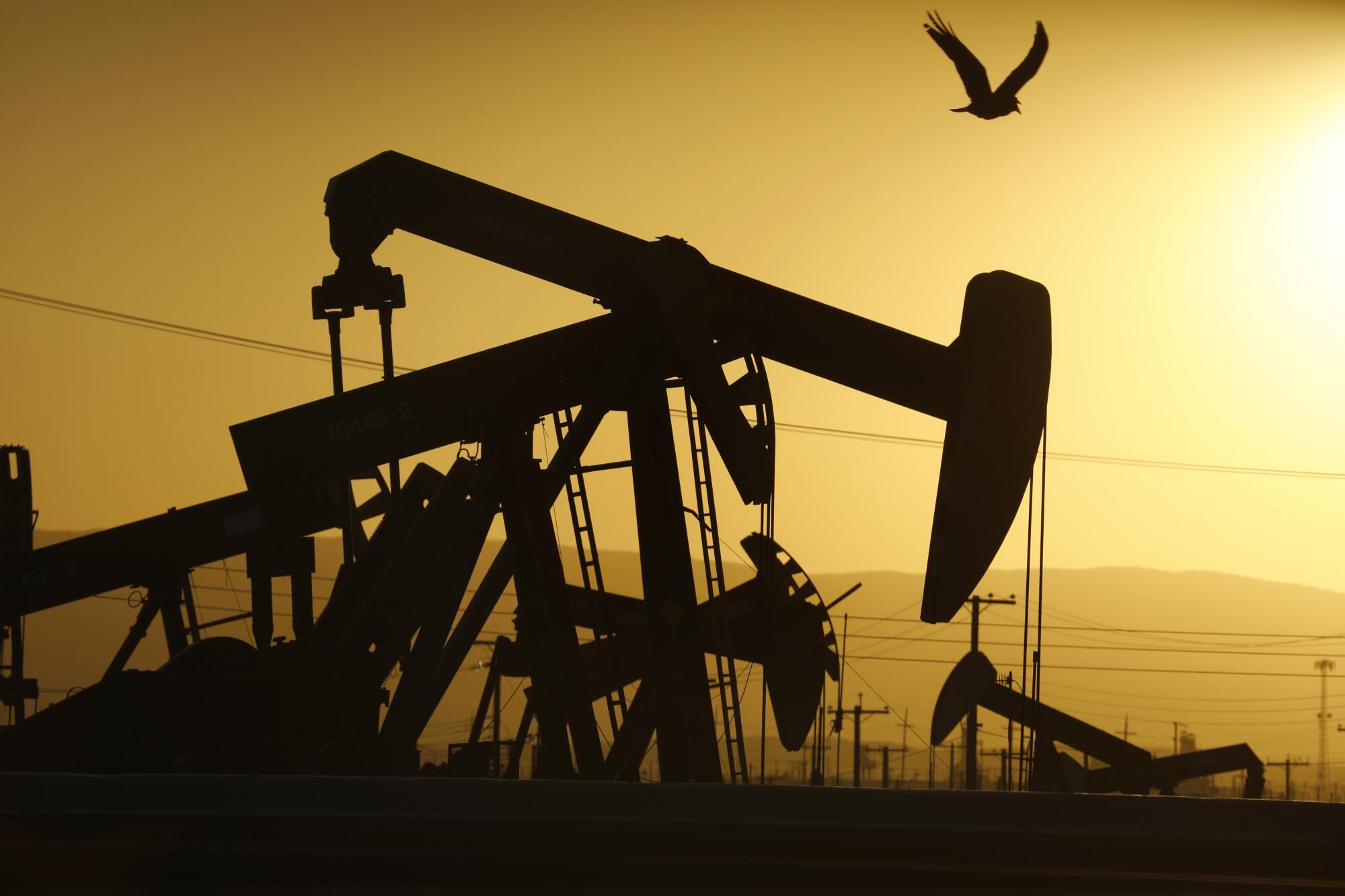
He added that estimates for the number of wells and people in harm’s way are likely conservative, as the study assessed wells drilled before 2020. That same year was California’s worst wildfire year on record, and saw more than 4.3 million acres burn.
The researchers also found that exposure to oil wells in the path of wildfires was unevenly distributed. Black, Latino and Native American people faced disproportionate risk.
The reasons for this are myriad, according to González.
For one, an estimated 350,000 new houses are constructed each year in the wildland urban interface, or the area where human development meets forestland and other natural landscapes. Such areas often draw people seeking lower costs of living, but face significant wildfire risks because of their remoteness and high vegetation content.
In urban areas, research has found that oil wells are more likely to be sited in neighborhoods that were historically redlined, or racially segregated. New wells are also disproportionately drilled in areas where Black and Latino people live.
Hundreds of unplugged oil wells puncture the urban landscape of Los Angeles. But the city has been reluctant to use its full powers to ensure cleanup and protect the public.
There are solutions, however — or at least recommendations to help mitigate the risks of oil wells in populated, wildfire-prone regions. California recently approved legislation that prohibits new oil and gas wells within 3,200 feet of homes, schools, healthcare facilities and other sensitive sites.
The state will also receive more than $35 million in federal funding to help plug and remediate more than 200 high-risk orphaned oil and gas wells, and plans to invest more than a quarter of a billion state and federal dollars into orphan well plugging in the coming years.
The researchers also recommended limiting or eliminating drilling in high wildfire risk areas, and investing in better technology for monitoring wells for leaks of flammable gases.
“There’s a strong base of evidence that active wells are harmful for people that live nearby — even in the absence of wildfires,” González said. “So I think from a public health perspective, additional protections are well justified.”
Mackey, of the California Department of Geologic Energy Management, said oil and gas operators in the state are subject to multiple layers of regulation, including requirements that well pads and tanks be kept free of vegetation, and that wells within specified distances of homes and public rights-of-way have fire prevention devices, sensors and alarm systems.
“In the event of a fire, CalGEM will contact affected field operators to warn them of the possible risk and discuss strategies to prevent damage to wells and equipment,” she said. “Operators are directed to close pipelines and tanks and shut off power to wells if they are not already doing so. Operators also have fire suppression capabilities they deploy during emergencies.”
During the Thomas fire, which was the largest in California at the time, the operators in Santa Barbara and Ventura counties shut down their wells, pipelines and rig work as part of their emergency response to mitigate the risk of fire-related incidents, she said.
Despite such efforts, the study also highlighted what it referred to as a “pernicious feedback loop.” The production and consumption of fossil fuels are driving global warming, which is in turn increasing the frequency and intensity of wildfires, it says. Greenhouse gases emitted by fires are also exacerbating climate change and contributing to the cycle.
González said he hopes the study will prompt more action to not only reduce wildfires, but also to better protect people living in or near the oil wells in their paths.
“We have an opportunity now to take action to prevent future disasters,” he said.
Toward a more sustainable California
Get Boiling Point, our newsletter exploring climate change, energy and the environment, and become part of the conversation — and the solution.
You may occasionally receive promotional content from the Los Angeles Times.

